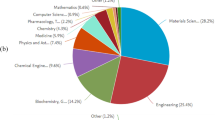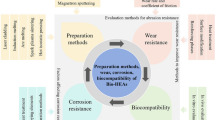Abstract
Metallic materials are mainly employed for the orthopaedic and dental implants because of high strength and appropriate ductility. Further, the implants are used for long term so that high fatigue strength is one of the most important properties in practical use. In addition, these implants are exposed to human body fluid, which is composed of corrosive liquid for metallic materials. In the case of metallic materials, corrosion sometimes accelerates the fatigue failure, that is, corrosion fatigue. Therefore, the effect of testing environment on fatigue strength should be also considered. In this chapter, the mechanical properties such as tensile properties and fatigue properties of the representative metallic materials for biomedical applications such as stainless steels, cobalt–chromium alloys, and titanium alloys in air and simulated body fluid are reviewed.
Access this chapter
Tax calculation will be finalised at checkout
Purchases are for personal use only
Similar content being viewed by others
References
Y. Okazaki, Comparison of fatigue properties and fatigue crack growth rates of various implantable metals. Materials 5(12), 2981–3005 (2012)
M. Niinomi, Mechanical properties of biomedical titanium alloys. Mater. Sci. Eng. A 243(1–2), 231–236 (1998)
J.H. Kim, M. Niinomi, T. Akahori, J. Takeda, H. Toda, Effect of microstructure on fatigue strength of bovine compact bones. JSME Int. J. Ser. A-Solid Mech. Mater. Eng. 48(4), 472–480 (2005)
T. Akahori, M. Niinomi, K. Fukunaga, I. Inagaki, Effects of microstructure on the short fatigue crack initiation and propagation characteristics of biomedical alpha/beta titanium alloys. Metall. Mater. Trans. A 31(8), 1949–1958 (2000)
T. Akahori, M. Niinomi, K.I. Fukunaga, An investigation of the effect of fatigue deformation on the residual mechanical properties of Ti–6Al–4V ELI. Metall. Mater. Trans. A 31(8), 1937–1948 (2000)
M. Niinomi, Fatigue characteristics of metallic biomaterials. Int. J. Fatigue 29(6), 992–1000 (2007)
M. Niinomi, T. Kobayashi, A. Akmoulin, Mechanical properties of titanium alloys. J. JILM 42(11), 605–613 (1992)
R.A. Antunes, M.C.L. de Oliveira, Corrosion fatigue of biomedical metallic alloys: mechanisms and mitigation. Acta Biomater. 8(3), 937–962 (2012)
M. Niinomi, T. Kobayashi, O. Toriyama, N. Kawakami, Y. Ishida, Y. Matsuyama, Fracture characteristics, microstructure, and tissue reaction of Ti–5Al–2.5Fe for orthopedic surgery. Metall. Mater. Trans. A 27(12), 3925–3935 (1996)
P. Kumar, A.J. Hickl, A.I. Asphahani, A. Lawley, Properties and characteristics of cast wrought and powder metallurgy (P/M) processed cobalt-chromium-molybdenum implant materials. ASTM STP 859, 30–56 (1985)
M. Niinomi, A. Saga, K. Fukunaga, Long crack growth behavior of implant material Ti–5Al–2.5Fe in air and simulated body environment related to microstructure. Int. J. Fatigue 22(10), 887–897 (2000)
J.D. Bolton, M.L. Redington, The effects of saline aqueous corrosion on fatigue crack growth rates in 316 grade stainless steels. Int. J. Fatigue 5(3), 155–163 (1983)
Y.-S. Lee, M. Niinomi, M. Nakai, K. Narita, H.H. Liu, Effect of solute oxygen on compressive fatigue strength of spinal fixation rods made of Ti–29Nb–13Ta–4.6Zr alloys. Mater Trans. 57(12), 1993–1997 (2016)
Author information
Authors and Affiliations
Corresponding author
Editor information
Editors and Affiliations
Rights and permissions
Copyright information
© 2019 Springer Nature Singapore Pte Ltd.
About this chapter
Cite this chapter
Nakai, M., Niinomi, M. (2019). Mechanical Property of Biomedical Materials. In: Setsuhara, Y., Kamiya, T., Yamaura, Si. (eds) Novel Structured Metallic and Inorganic Materials. Springer, Singapore. https://doi.org/10.1007/978-981-13-7611-5_26
Download citation
DOI: https://doi.org/10.1007/978-981-13-7611-5_26
Published:
Publisher Name: Springer, Singapore
Print ISBN: 978-981-13-7610-8
Online ISBN: 978-981-13-7611-5
eBook Packages: Chemistry and Materials ScienceChemistry and Material Science (R0)




